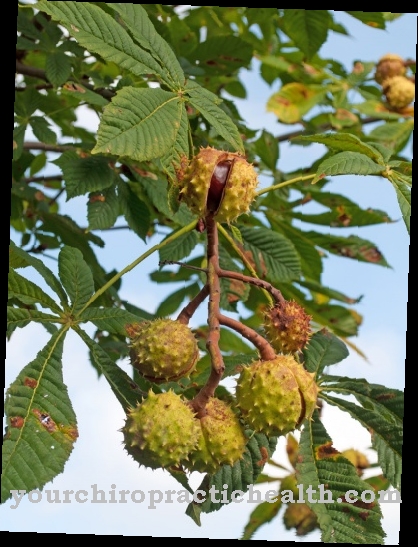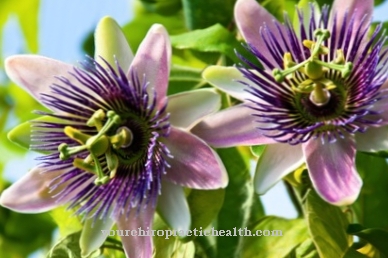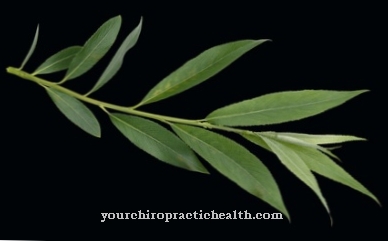The African devil's claw owes its name to the claw-shaped appearance of its fruits. The storage roots of the plant native to Africa are used medicinally. Their anti-inflammatory and pain-relieving effects are mainly used in the treatment of rheumatism and osteoarthritis.
Occurrence & cultivation of the devil's claw

From their large, reddish flowers, claw-shaped fruits form, which stick to the fur of animals and thus ensure the spread of the plant. So-called secondary tubers form on the runners of a thick main root. It is they that contain the most active ingredients and are used medicinally. The African devil's claw is dependent on a hot climate and sandy soil, it cannot be cultivated in other climatic zones.
Due to its limited availability, the coveted medicinal plant is now one of the endangered species. A plant from the bluebell family that occurs in Europe and is also called devil's claw has nothing to do with Harpagophytum procumbens and is not medically relevant.
Effect & application
The harpagosides are among the most important active ingredients contained in the devil's claw. They have a pain-relieving and anti-inflammatory effect and have a regulating effect on the heart rhythm and blood pressure. The plant also contains flavonoids, acteosides, unsaturated fatty acids, cinnamic and chlorogenic acids.
An extract from the devil's claw root has a supportive effect in the treatment of inflammatory rheumatic complaints, joint pain due to wear and tear (osteoarthritis), chronic back pain and tendinitis (e.g. tennis elbow). Studies have shown that the anti-inflammatory properties of Harpagophytum procumbens take a different route than the use of conventional anti-inflammatory drugs. The devil's claw also seems to block certain pain-releasing or pain-intensifying messenger substances in the body or to inhibit their production.
Traditionally, the plant is also used for gastrointestinal complaints, loss of appetite, digestive disorders such as diarrhea, flatulence or constipation as well as problems of the urinary organs. The bitter substances it contains promote saliva production and digestive activity and thus also stimulate the appetite. They lower the pH in the stomach and stimulate the bile (this is called the choleretic effect).
The devil's claw also has a blood thinning effect. For patients with arteriosclerosis this is a welcome effect, but for people with a tendency to bleed it is a risk factor that must be taken into account, especially in the case of high-dose or long-term use. In the case of existing gastric ulcers, one should completely avoid taking it, at least greater caution is required during pregnancy (there are not yet sufficient studies here).
The devil's claw root can be used internally and externally, depending on the indication. It is taken as a tea, as a self-made tincture or as a ready-made preparation in the form of capsules, tablets or powder. Such finished preparations are probably the most common variant and are available almost everywhere, from pharmacies to food discounters. It is important to note the different high levels of active ingredient and the correspondingly different strengths of the dry extract preparations.
In addition to being taken internally, tea brews or diluted tinctures are also suitable for external use for compresses, baths and washes. Ointment preparations with the active ingredients of the devil's claw are also used. They help with chronic skin problems, eczema, psoriasis and even poorly healing wounds.
Importance for health, treatment & prevention
The diverse healing powers of Harpagophytum procumbens have been known in their homeland for centuries and are traditionally used by African healers. It was not until the beginning of the 20th century that a German soldier got to know this tradition locally and brought his knowledge with him to Europe.
Here in 1930, the botanist Otto Heinrich Volk began pharmaceutical research on the plant. With the knowledge about the therapeutic effect of the devil's claw, the worldwide demand for corresponding preparations increased steadily. A real overexploitation of the wild plants began, so that they were soon threateningly decimated.
Today the plant is only broken down in a controlled manner. You just remove the thick side roots and then let the plant regenerate over several years. The stock is better protected as a result, but global demand cannot be met from natural resources. Attempts are being made to specifically cultivate devil's claw outside of Africa - so far a difficult undertaking with only moderate prospects of success.
The role of the devil's claw root in the prevention and treatment of various ailments depends on the individual clinical picture. According to clinical studies, their effect is more effective in chronic joint inflammation than in acute inflammatory processes. While it can usually only play a supporting role in the treatment of severe pain, it can be used as the sole remedy for lighter complaints.
Chronic pain patients in particular are often grateful for such alternatives from nature that help save chemical drugs. Unpleasant side effects and long-term consequential damage can thus be avoided or at least significantly reduced. However, Harpagophytum procumbens is not suitable for the treatment of acute or severe pain because it takes between two and four weeks for the desired effect to set in.
Classical homeopathy also uses the healing power of the African devil's claw, typically in potencies from D2 to D6. The main areas of application here are osteoarthritis and disc problems. Gout, ankylosing spondylitis, but also skin diseases such as shingles are also among the areas of application.
























.jpg)



